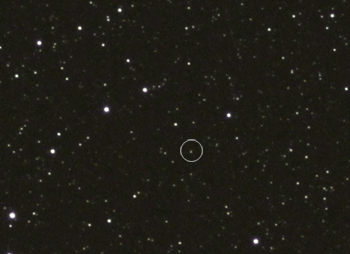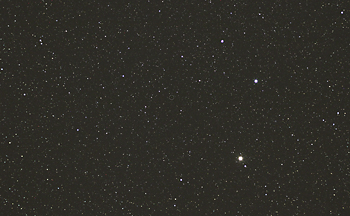|
| |
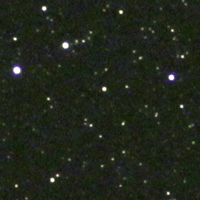 |
Special Projects
- Project Pluto -
or "Back to the roots" by Dr. L. Schmadel,
Dipl.-Ing. W. Paech und Dipl.-Ing. F. Hofmann
Abstract:
This site describes the attempt to take an image of the dwarf
planet Pluto with modern photographic technology and a 2-inch
telescope.
Back to Special
Projects |
|
 |
|
|
July 11-13, 2015 - Project Pluto
A few years ago, probably at the time when the Pluto
probe New Horizons was launched, Dr. Schmadel from the Astronomical Data Center
Heidelberg and Dipl.-Ing. Paech sat with a beer together. Somehow the idea
arised whether it is possible to take an image of Pluto with a classic 2-inch
telescope and modern photographic technology or whether a larger telescope
is necessary.
The idea
disappeared over the years out of the heads, but arised again with the planning
of the Namibia stay from Paech in 2015. In these days the New Horizons probe
should also reach its destination. So the project Pluto was revived and a
two-inch telescope was needed. All of the following images can be
enlarged by clicking on it.
|
 |
|
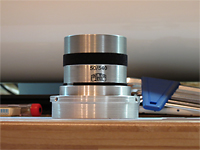 |
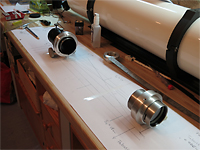 |
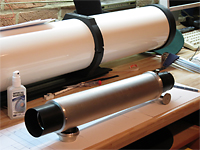 |
The
objective should have a better quality than the cheap Chinese products. And it
should have precisely an aperture of 2 inch.
Zeiss Jena sold the
traditional 50/540 mm lens for decades. Therefore contact with Baader
Planetarium was established because they once offered the complete range of
Zeiss amateur products. |
|
Mr. Thomas
Baader was very interested in the project and searched and found a Zeiss Jena
objective FH 50/540 mm "deep in the Baader Planetarium cellar" and made it
available for the project. The 50/540 mm was traditionally sold as C-lens, but
there were some lenses designed as Fraunhofer lenses, i.e. the FH 50/540 mm.
The focal ratio is f / 10.8.
This small telescope was built in the
cellar by Paech. The focuser comes from the "leftovers box" and is not very
good. A tipping of the tube was minimized by a very tight installation of the
rack into the flange. The three pictures above show (from left to right) the
Zeiss lens, the sketch of the tube and the finished "Pluto telescope" before
painting. The large telescope in the background is a 125 mm refractor under
construction.
|
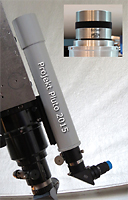 |
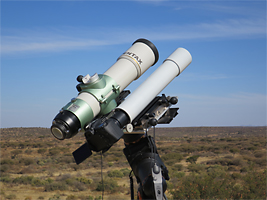 |
The
finished telescope was roughly tested for its imaging quality and focal
position in Germany by Paech. Afterwards it was wrapped in a padded poster roll
and went off in a normal case to Namibia.
In Namibia it was mounted on a
transportable Celestron CGEM-DX. In parallel, a Pentax 105, which served as
guiding telescope. A Canon EOS 60 D was used for taking the
images.
In the night from 10.7. to
11.7. some test images were taken for checking the imaging quality and the
limiting magnitude. |
|
The
two images to the right show Eta Carinae (NGC 3372) and "Herschel's jewel box"
(NGC 4755, the brightening the lower image comes from the star Beta Crucis).
The exposure was 5 x 120 seconds at 640 ASA (NGC 3372) and 5 x 60 seconds (NGC
4755). The night temperature was about 15 degrees celsius (it was spring in
Namibia).
Apart from the expected blue halos (mitigated in image
processing) and elongated stars in the corners shows the lens a decent
figure. |
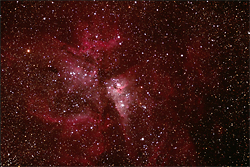 |
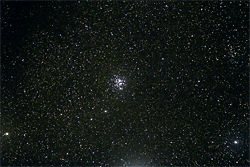 |
|
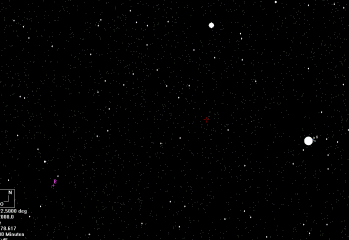 |
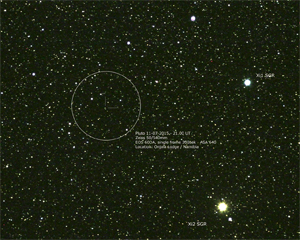 |
Pluto
was at that time in the constellation Sagittarius, near the stars Xi 1 and Xi 2
with a brightness of 14.3 mag. Compared to the discoverer - Claude Tombaught -
we have the advantage of knowing the exact position of Pluto from a planetarium
program. The left image shows a gif animation between GUIDE 9.0 (by the company
Project Pluto - Nomen est omen :-)) and a telescopic image (11.07.2015, 640
ASA, 300 seconds). In the right image Pluto is marked.
Both images can be enlarged by
clicking on it. |
|
Unfortunately Pluto was very close to a 14.86 mag star in the first
image and we had some tracking errors in the 5 images. On 12 and 13 July the
images were taken again, also for verifying the proper
motion.
|
|
|
Conclusion: There are 5 good images (800 ASA, t = 300 seconds)
in Canon raw format from the night between July 12 and 13. The images here are
single images in jpg format. The image quality shown here is expected to
improve with the addition of the raw images. But already, the single images
(limiting magnitude about 16 mag.) show Pluto clear and obvious. It can be
said: project Pluto successfully completed. It does not always have the 20
inch model, also with small telescopes you can get great
results.
Many thanks to Mr. Thomas Baader and
the Staff of Onjala Lodge in Namibia for supporting the "Project
Pluto"
|
|
|
| All Images and all Content are © by Franz Hofmann
+ Wolfgang Paech |



